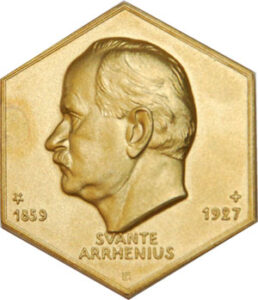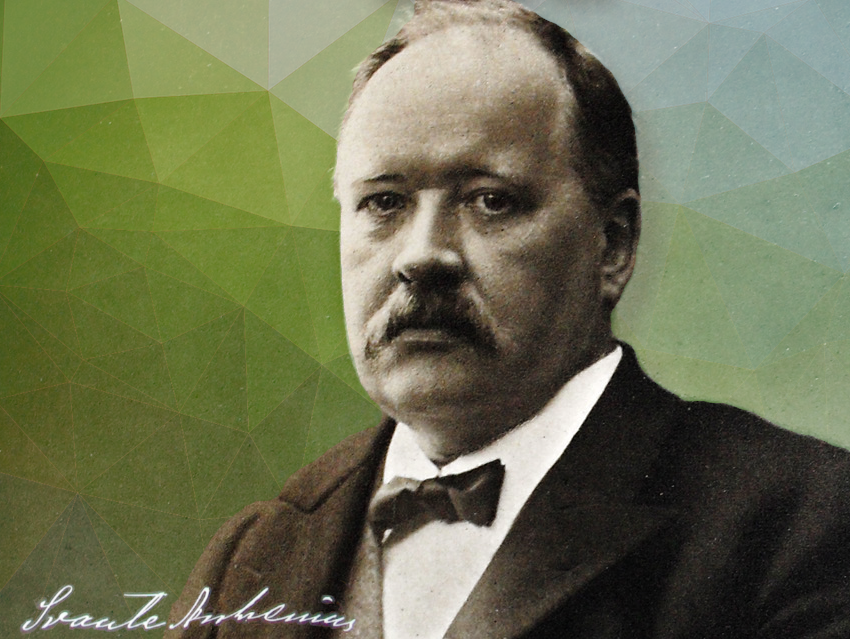Although initially trained as a physicist, Svante Arrhenius is often associated with the field of chemistry and is considered one of the founders of physical chemistry. His groundbreaking contributions to the field earned Svante Arrhenius the Nobel Prize in Chemistry in 1903, making him the first person from Sweden to receive this prestigious award. He is best known for his work on the theory of electrolytic dissociation, activation energy, and the pioneering theory of global warming.
1 Svante Arrhenius’ Journey to Success
Svante August Arrhenius was born on February 19, 1859, on the estate of Wik on Lake Mälaren, close to Uppsala in Sweden. He is said to have learned to read at the age of three, excelled as a child as a mental calculator, and early on showed a particular interest in mathematics and physics. In 1876, he began studying mathematics and natural sciences at Uppsala University, and in 1881, he transferred to Stockholm University, Sweden, where he received his doctorate in 1884.
His doctoral thesis, written in French, was titled “Recherches sur la conductibilité galvanique des électrolytes.” At that time, it was known that table salt consisted of chlorine and sodium. Sodium and chlorine atoms were thought to be highly reactive, and it seemed highly unlikely at the time that these atoms could move freely in the solution, as the smell of chlorine should have been detectable. Arrhenius proposed that solid crystalline salts disassociate into paired charged particles in solution. His dissertation received a very poor evaluation, and he was not given the opportunity to habilitate.
However, Wilhelm Ostwald (1853 – 1932) was able to experimentally confirm Arrhenius’s ideas at the Polytechnic in Riga, which was then part of Livonia, and even came to Stockholm to personally meet the young scientist. Ostwald offered Arrhenius a professorship in Riga, which he could not initially accept due to his father’s serious illness.
After receiving a generous travel scholarship from the Swedish Academy of Sciences, Svante Arrhenius traveled throughout Europe. He followed Ostwald to Riga in 1885, worked with Friedrich Kohlrausch and his doctoral student Walther Nernst in Würzburg, Germany, in 1886, went to Ludwig Boltzmann in Graz, Austria, then to van ‘t Hoff in Amsterdam, The Netherlands, in 1887, and in 1888 back to Ostwald, who was now teaching in Leipzig, Germany. After a brief stay in his homeland, Arrhenius worked again in Leipzig at Ostwald’s Physical-Chemical Institute and in Graz in 1889/90.
In 1891, Arrhenius took a position as “Laboratory Director for Physics” at the University of Stockholm. He declined a professorship in Gießen, Germany, which had also been offered to him. In 1895, his position in Stockholm was converted to a professorship. He received the Nobel Prize in Chemistry in 1903, and in 1905, he went to the Nobel Institute for Physical Chemistry.
As an older man, Arrhenius had many administrative duties due to his various positions, but he invested a lot of time in his research and publication work and did not spare his health, such as getting up at four o’clock in the morning to work on a new edition of “The Formation of the Worlds”. He suffered a weakness attack at the end of 1925 from which he did not fully recover. In the spring of 1927, Arrhenius resigned as Director of the Nobel Institute and in the summer he wrote his unfinished memoirs. At the end of September, he was struggling with acute gastroenteritis, which he succumbed to on October 2, 1927. As he wished, he was buried in Uppsala.
 Svante Arrhenius was a member of numerous academic and scientific societies in Sweden and abroad, including the Royal Society of Sciences in Uppsala, the Royal Swedish Academy of Sciences, and the Russian Academy of Sciences. He was also honored with numerous awards and honorary doctorates from universities, including the Davy Medal from the Royal Society and the Nobel Prize in Chemistry in 1903. Additionally, several celestial bodies and a scientific award are named after him: The Swedish Chemical Society has been awarding the Arrhenius-plaketten annually since 1962 for outstanding scientific research in the field of chemistry [1].
Svante Arrhenius was a member of numerous academic and scientific societies in Sweden and abroad, including the Royal Society of Sciences in Uppsala, the Royal Swedish Academy of Sciences, and the Russian Academy of Sciences. He was also honored with numerous awards and honorary doctorates from universities, including the Davy Medal from the Royal Society and the Nobel Prize in Chemistry in 1903. Additionally, several celestial bodies and a scientific award are named after him: The Swedish Chemical Society has been awarding the Arrhenius-plaketten annually since 1962 for outstanding scientific research in the field of chemistry [1].
2 Scientific Work
Arrhenius conducted research in various fields, such as physical chemistry, physiology, geology, meteorology, and astrophysics. Some of his most significant contributions were the development of the basics of ionic disassociation [2] and the estimation of the effects of CO2 increases in the atmosphere on global temperatures via the greenhouse effect—a concept that is central to modern climate science [3,4].
2.1 Electrolytic Dissociation of Solutions
Arrhenius made a significant contribution to the theory of the electrolytic dissociation of solutions. He studied how electrical current is conducted in chemical solutions. In his dissertation, he proposed that electrolytes disassociate into paired charged particles, i.e., ions, when dissolved. Depending on the substance and the concentration of the solution, they dissociate to varying degrees.
In 1887, Arrhenius wrote an article on his dissociation theory [2], introducing the term “activity coefficient”. The activity coefficient indicates the proportion of dissolved ions (“active” molecules) to the sum of dissolved and undissolved (“inactive”) particles of that type. Arrhenius used conductivity measurements to determine the degree of dissociation of electrolytes. He concluded from these measurements that in very dilute solutions, the activity coefficient approaches 1, i.e., the electrolytes are fully dissociated into ions. In concentrated solutions, the activity coefficient is less than 1.
Arrhenius later proved the influence of electrolytic dissociation on the osmotic pressure, the lowering of the freezing point, and the increase of the boiling point of solutions containing electrolytes [5]. The Nobel Prize in Chemistry 1903 was awarded to Svante Arrhenius “in recognition of the extraordinary services he has rendered to the advancement of chemistry by his electrolytic theory of dissociation.”
2.2 Arrhenius Equation
The Arrhenius equation is a formula that describes the temperature dependence of the rate of chemical reactions. It was introduced by Arrhenius in 1889 [6,7].
The equation shows the dependence of the rate constant k of a chemical reaction on the temperature T, with the activation energy of the reaction Ea, a pre-exponential factor A (also called the frequency factor), and R as the universal gas constant:
![]()
The equation is based on the concept that chemical reactions occur when molecules collide with sufficient energy and in the proper orientation. Explained in simple terms, k is the rate of collisions that result in a reaction, A is the rate of collisions occurring with the proper orientation to react, and e-Ea/(RT) is the probability that any given collision will result in a reaction.
2.3 The Greenhouse Effect
In 1896, Arrhenius proposed a theory on the greenhouse effect. He wanted to determine whether greenhouse gases could contribute to explaining the temperature variations between ice ages and the periods of warmer climate between them. He calculated estimates for the extent to which a raise in the atmospheric CO2 concentration increases the Earth’s surface temperature via the absorption and re-emission of heat radiation—i.e., the greenhouse effect. Based on these calculations, Arrhenius was the first to predict that emissions of carbon dioxide from the burning of fossil fuels and other combustion processes were large enough to cause global warming [3,4].
2.4 Other Work
In addition to his work on electrolytic dissociation and kinetics, Arrhenius also conducted research on the atmosphere and meteorology, as well as physiology, where he studied physiological problems in terms of chemical theory. He also branched out to astronomy and proposed theories for the cause of, e.g., the polar lights and the origin of life on our planet.
3 Arrhenius’ Dual Legacy
Despite being renowned for his contributions to the field of chemistry, Arrhenius was also a member of the board of the Swedish Society of Racial Hygiene, an organization that was established in 1909 with the goal of promoting eugenics [8]. The Swedish government established the State Institute for Racial Biology twelve years later. This eventually led to a state-sanctioned program of racial purity that resulted in the forced sterilization of approximately 63,000 individuals, mostly women, from 1934 to 1976.
References
[1] Svenska Kemisamfundet (SK, Swedish Chemical Society), Arrhenius-plaketten, kemisamfundet.se. (accessed February 20, 2023)
[2] S. Arrhenius, Über die Dissociation der in Wasser gelösten Stoffe, Z. Phys. Chem. 1887, 1, 631–648. https://doi.org/10.1515/zpch-1887-0164
[3] S. Arrhenius, On the influence of carbonic acid in the air upon the temperature of the ground, Lond. Edinb. Dublin Philos. Mag. J. Sci. 1896, 41, 237–276. https://doi.org/10.1080/14786449608620846
[4] S. Arrhenius, On the Influence of Carbonic Acid in the Air Upon the Temperature of the Ground, Publ. Astron. Soc. Pac. 1897, 9, 14. https://doi.org/10.1086/121158
[5] Svante Arrhenius – Biographical, Nobel Lectures, Chemistry 1901-1921, Elsevier Publishing Company, Amsterdam, 1966.
[6] S. Arrhenius, Über die Dissociationswärme und den Einfluß der Temperatur auf den Dissociationsgrad der Elektrolyte, Z. Phys. Chem. 1889, 4, 96–116. https://doi.org/10.1515/zpch-1889-0408
[7] A S. Arrhenius, Über die Reaktionsgeschwindigkeit bei der Inversion von Rohrzucker durch Säuren, Z. Phys. Chem. 1889, 4, 226–48. https://doi.org/10.1515/zpch-1889-0416
[8] N. Ball, Arrhenius, Svante, eugenicsarchive.ca. (accessed March 7, 2023)




